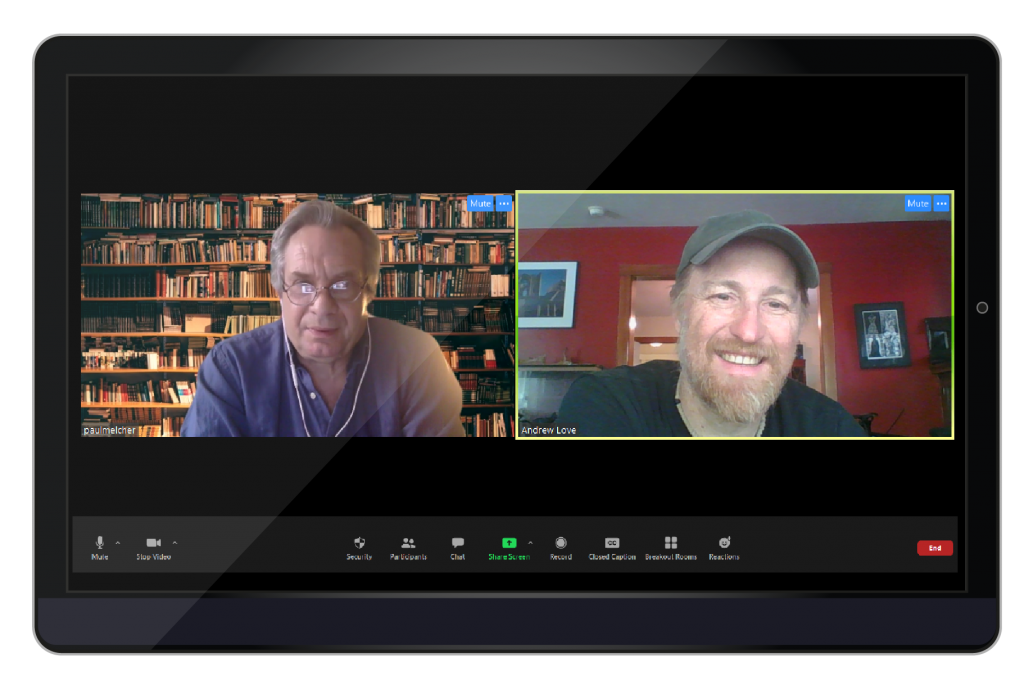
Paul Melcher
Business Development
Imatag
Andrew Love
Brand Protection and Investigations
Specialized Bicycles
Note from Andrew
Hello from lockdown! Wherever you are in the world,
whenever you read this (I am writing this May 8th at 12:17pm MT) I send you and your family health and sanity in these difficult times. My brother is a public-school teacher in NYC, and has lost close colleagues to COVID-19.

Paul, you are in Manhattan, just like my brother, how are things there?

The other day, while coming back from a bike ride, on a Sunday afternoon, I stopped at a red light, on 6th Avenue, in the heart of Greenwich Village. As I waited for the light to change, I heard footsteps in the not too far distance. I looked up, and a woman was crossing 6th Avenue, her heels hitting the pavement loudly at each step. This is when it hit: The silence was so predominant that her footsteps were an unusual intrusion. We, the two of us, were alone, on a Sunday afternoon, in Manhattan. No cars, no people, nothing. And the only noise I could hear were her footsteps.
In regular times, a silent New York street is a welcome event. While the mind enjoyed the silence, the rest of the body warned that there was something terribly wrong with the whole situation.

Wow…strange times. Ok, big picture question moving from the audible to visual— are we living in the age of the image?
Digital image specifically?

Certainly so. Images, in some vital part of our lives, have replaced text. In this context we shop via pictures, only to see and touch the real product after we purchased it when it finally reaches our homes.

This is a time of the professional photographer with photoshop and a studio, but my gut says it’s more than that. Elaborate.

We all carry cameras with us all the time and use them to communicate. We communicate our emotions via emojis, we describe things by sharing photos. The rise of social media has been made possible because of images. Snapchat, Instagram, Pinterest, Facebook are all photo /video sharing platforms — and we share experiences via homemade videos.

I met you in the context of a story that is incredibly relevant to brand protection. Let’s revisit that story.

Early in my career, I went to a job interview at a New York-based photo agency. The owner sat me down and asked me if I would help him run films from fashion shows to the nearest photo lab.
“You see,” he said, ”we process images of each cloth on the runway and send it to cloth manufacturers who would like to make copies.”
“Is that legal?” I said.
“Sure,” he replied. “we don’t make copies, they do. Plus, clothes don’t have copyrights.”
I was silent.
“These guys have copies of the clothes in stores before the actual designers who presented them on the runway. They pay us well to get those images.”
I didn’t take the job. But the story stood with me. Mostly because, when I talked about this to other people, including some in the fashion industry, everyone seemed familiar with the process. Designers weren’t happy, but they couldn’t do much about it.

This is…… crazy…..

Indeed. But things haven’t changed that much. Images are still being used to make copies of fashion. The difference is they are now available online, for free, and within minutes of the shows. So, it is even cheaper and faster.

I had an experience in 2012 that I will never forget. Our professional mountain bike team did its first races in March, wearing the Specialized team issue jersey. We made the jersey in a limited run for the team. Photos of our athletes winning in this jersey were all over cycling media. By the end of April, the counterfeiters had a copy for sale you could get in a week. We didn’t receive our first containers of these jerseys for mass release to the public and our bike shops until July.
The counterfeiters beat us to market with our own product!

No surprise. Not only do counterfeiters now have easy access to models via free photos they find online, they also can have a very good idea of the potential popularity of each item by just looking at the popularity of the photos themselves. It’s like having a free market research.

Instagram “likes” as counterfeiter research! Whoa… Give me some more examples of how the “Age of the Image” is playing out.

Photography’s symbiotic relationship with counterfeiting is not just limited to fashion or covering sporting events. Also cars, electronics, toys, furniture. Since everything has easily available pictures, it is easier to copy. Images help in making copies, and the same images help in selling those copies.
All counterfeiters need to do is go to the brand’s website, download the images of the product they counterfeited and post them on their website. That’s it. It’s that simple.

So, I truly understand that counterfeiters have their own photoshop departments, photo booths and product promotion photos.

Counterfeiters know that in today’s economy, if they can use images of the real product to sell their illegal copies, they have succeeded because as commerce moves online, products move via images. Unlike brick and mortar, where customers get to see, touch and interact with the product they will purchase, the online experience happens entirely via photographs. Online, people shop via images of the product they want to buy, not the actual product. And while those photos can be of the real product, the item they will receive can be a counterfeit.

And, to protect yourself, you recommend a digital watermark? What other kind of assets should be digitally watermarked?

Any asset that either describes the product or sells it. Videos, for example, can also easily be used by counterfeiters. In fact, they can make the product seem even more legitimate when offered online. 3D rendering as well. If those escape and are shared before a product is launched, they can do irreparable damage to a brand. Copies can hit the market sooner than the real thing and devastate a new product launch. The ability to locate the source of the leak using forensic watermarking can greatly reduce or prevent this type of event.
Any visual asset that describes or sells a product should be watermarked. This guarantees that any illegitimate use can be found and behind it, any counterfeiting operation closed down.

Water is one of the world’s “irresistible forces” in nature. We know what it can do to a landscape or a mountain, both over eons and sometimes overnight with a Tidal wave…So powerful many industries have a fancy term for it. Hydroforming.
So we are in a digital version of that time? A “watermark” showing true ownership of an image?

In a way, yes. Invisible watermarks hijack the symbiotic relationship between counterfeiters and photography. Instead of an accomplice to illegal products, visuals become a finger-pointing device to uncover illicit copies.

Much, much, much to think about here… Thanks for the vision and the discussion, and the protection tactics that flow from this idea.
THE BRAND PROTECTION PROFESSIONAL | JUNE 2020 | VOLUME 5 NUMBER 2
COPYRIGHT 2020 MICHIGAN STATE UNIVERSITY BOARD OF TRUSTEES
